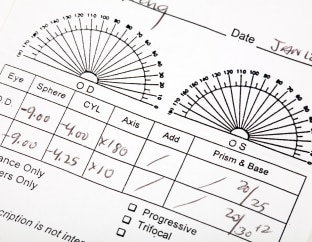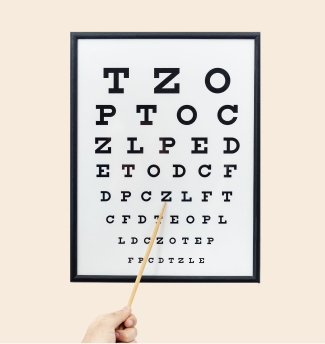Skip to main content
If you've needed vision correction for a while, you likely know whether you’re nearsighted, farsighted or have astigmatism. While it's important to know what your vision needs are, reading and understanding your prescription is another thing entirely.
It's possible that your vision prescription will change from year to year. If this is the case for you, you'll need to order new glasses using your updated prescription information. Most online retailers ask you to submit this information during the checkout process, but if you don’t know how to read your prescription, things can get complicated.
Fortunately, we’ve put together a short guide on how to read a glasses prescription so you can be fully informed when ordering your next pair of eyeglasses.
The numbers on your eyeglass prescription describe how the lenses of your glasses should be ground to provide you with the most accurate vision correction. Typically, you’ll see several abbreviations and words labeling all the important data on your prescription. Some of the most common terms you'll see include O.D., O.S., SPH, CYL, Axis, and more.

The abbreviations O.D. and O.S. are used to differentiate your right and left eye.
O.D. is short for the Latin term oculus dexter, which means “right eye.”
O.S. is an abbreviation of the Latin term oculus sinister, which means “left eye.” You’ll see these terms on nearly every eyeglass prescription.
Sphere: The sphere (SPH) on your prescription indicates the single-vision lens power you need to see clearly. A minus (-) symbol next to this number means you’re nearsighted, and a plus (+) symbol means your prescription is meant to correct farsightedness.
Cylinder: A number under the cylinder (CYL) column indicates a prescription is needed to correct your astigmatism. If this column is blank, it means you don’t have astigmatism. The number in the CYL column reflects the lens power in a specific axis that is needed for astigmatism correction.
Axis: If you have astigmatism, there will also be a number in the Axis column. This number indicates the orientation of the cylinder prescription.
A nearsighted prescription will feature a number with a minus (-) symbol in the Sphere box. This means your lenses will be shaped to improve your distance vision.
| Vision à distance | OD |
| OG | |
| Sphère | Cylindre |
| -4.00 | |
| -5.00 | -0.50 |
| Axe | Prisme |
| 180 |
| Base | Add |
A prescription for someone who is farsighted will feature a number with a plus (+) symbol in the Sphere box. This indicates that your lens should be shaped to correct near vision and perhaps your distance vision as well, since both can sometimes be blurry if you are farsighted.
| Vision à distance | OD |
| OG | |
| Sphère | Cylindre |
| +2.00 | |
| +2.00 | -0.50 |
| Axe | Prisme |
| 180 |
| Base | Add |
If you have astigmatism, you will have a number in the Cylinder column of your prescription that indicates the lens power needed to correct it. There will also be a number in the Axis column that gives further details for making your corrective lenses accurately.
| Vision à distance | OD |
| OG | |
| Sphère | Cylindre |
| -4.00 | |
| -5.00 | -0.50 |
| Axe | Prisme |
| 180 |
| Base | Add |
A bifocal or multifocal prescription will include an Add value for the reading part of the lens, sometimes marked as NV (short for near vision). This indicates the required strength for the near prescription in your lens.
| RX | |
| Multifocaux | OD |
| OG | |
| Sphère | Cylindre |
| -4.00 | |
| -5.00 | -0.50 |
| Axe | Add |
| +2.00 | |
| 180 | +2.00 |
A prescription that corrects eye alignment issues will include a Prism strength and Base orientation. These are needed to determine the strength and position of the prism in the lens so that it accurately aligns the eyes of the person wearing the glasses.
The Base orientation will be either “base in” (BI) and “base out” (BO), or “base up” (BU) and “base down” (BD), indicating in which direction the base of the prism should be positioned.
| Vision à distance | OD |
| OG | |
| Sphère | Cylindre |
| -4.00 | |
| -5.00 | -0.50 |
| Axe | Prisme |
| 180 |
| Base | Add |
| Haut | +2.00 |
| Bas | +2.00 |

Si vous n'avez aucun problème médical affectant votre vision, vous devriez passer un examen de la vue complet tous les un à deux ans.
Children should have their first eye exam when they are around six months old, and then another just before they start school. Poor vision can seriously impact a child’s learning, so having an eye exam around age 5 or 6 ensures they can see clearly in class. They should also have annual eye exams during their school years, or as recommended by their eye doctor.
Maintenant que vous comprenez ces mystérieuses lettres et chiffres, vous savez lire une ordonnance de lunettes de vue ! Savoir ce qu'ils signifient vous aidera également à discuter plus facilement de votre ordonnance avec votre professionnel de la vue.